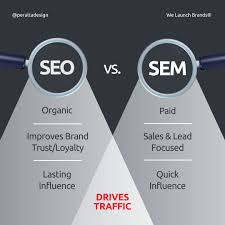SEO and SEM: 5 Key Differences Explained (SEO vs SEM Guide 2025)
Confused between SEO and SEM? Discover the 5 key differences between SEO and SEM, their benefits, and how to use both for maximum online visibility in 2025.
SEO Title
SEO and SEM: 5 Key Differences & How to Use Both in 2025
Introduction
In the fast-paced world of digital marketing, SEO and SEM are two essential strategies for increasing your website’s visibility and attracting more customers. While both aim to improve your search engine rankings, they work in different ways and serve distinct purposes.
Many business owners and marketers use the terms SEO (Search Engine Optimization) and SEM (Search Engine Marketing) interchangeably, but understanding their differences is crucial for creating an effective online strategy. This guide will explain the 5 main differences between SEO and SEM, their unique advantages, and how to use both to achieve your business goals.

1. Definition: What Are SEO and SEM?
SEO (Search Engine Optimization)
SEO is the practice of optimizing your website to rank higher in organic (unpaid) search results. It involves a variety of techniques, such as:
- Keyword research to find out what your audience is searching for.
- On-page optimization, including meta tags, headings, and high-quality content.
- Technical SEO, which ensures your site is fast, secure, and easy for search engines to crawl.
- Off-page SEO, primarily focused on earning backlinks from authoritative websites.
The goal of SEO is to attract free, long-term traffic from search engines like Google, Bing, and Yahoo.
SEM (Search Engine Marketing)
- Includes both SEO and paid advertising (PPC).
- Primarily refers to paid search ads (Google Ads, Bing Ads).
- Goal: Immediate visibility and quick traffic boost.
2. Cost: Free vs. Paid
SEO: Low Cost, High Effort
- No direct ad spend, but requires investment in content, SEO tools, and expertise.
- Results take 3-6 months to appear.
SEM: Paid for Instant Results
- Pay-per-click (PPC) model—you pay for each click on your ad.
- Immediate traffic, but stops when you pause ads.
3. Traffic Source: Organic vs. Paid
SEO: Organic Traffic
- Users find your site naturally through search engines.
- Higher trust and credibility over time.
SEM: Paid Traffic
- Users click on sponsored ads at the top of search results.
- Fast results, but traffic depends on ad budget.
4. Time to See Results
SEO: Long-Term Strategy
- Takes months to rank higher.
- Sustainable growth with lasting benefits.
SEM: Instant Visibility
- Ads appear within hours of launching.
- Best for short-term promotions and quick leads.
5. Key Performance Indicators (KPIs)
SEO KPIs
- Organic traffic growth
- Keyword rankings
- Backlink quality
- Bounce rate & time on site
SEM KPIs
- Click-through rate (CTR)
- Cost per click (CPC)
- Conversion rate
- Return on ad spend (ROAS)

SEO and SEM: Which One Should You Use?
| Strategy | Best For | Time to Results | Cost | Sustainability |
|---|---|---|---|---|
| SEO | Long-term growth, brand authority, content marketing | 3-6+ months | Low (effort-based) | High |
| SEM | Quick leads, promotions, sales, testing new markets | Immediate | High (ad spend) | Low |
For best results, use both!
- SEO builds a strong foundation.
- SEM accelerates visibility and conversions.
Conclusion
Understanding the differences between SEO and SEM is essential for any business looking to succeed online. While SEO is a long-term investment that builds credibility and sustainable traffic, SEM offers quick wins and immediate visibility.
By combining both strategies, you can enjoy the best of both worlds: fast results from SEM and lasting growth from SEO.
Need help with your SEO and SEM strategy? Reach out for a free consultation and start maximizing your search engine success today!
Call to Action: What’s your biggest challenge with SEO and SEM? Share your thoughts in the comments, or contact us to discuss how we can help you dominate search rankings in 2025! contact us
